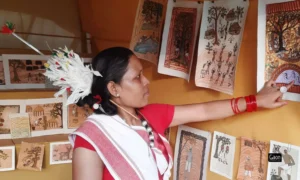It was the fourth time that day when my head hit the top of the low-rise door frame of my dwelling. After the first episode, which left a small lump on my head, I made a mental note to take care while crossing the threshold. Old habits die hard, and I scored the fourth hit.
It is not only the doorframe, but I have also to get used to the shape of my lodging. After having lived all my life in rectangular rooms, staying in a circular “room” does get a bit disorienting.
I am in Mongolia, and I am staying in a ger (pronounced ‘gaire’).
A Ger is a dwelling of the nomads of Mongolia, which has retained its design for centuries. You dare not call it a yurt though they are essentially the same. Yurt is a word used by their neighbours, the Russians.

Ancient gers could not be dismantled and had to be wheeled from one location to the other sometimes pulled by as many as 22 yaks.
The nomads of Central Asia move with the season, seeking fodder for their herds of cattle. And this fodder is aplenty in the endless rolling steppes, a carpet of clean, green grass as far as your eyes can see.
Baatar, our guide, explains, “Ger means a house and a family. We are at the National Museum at Ulaanbaatar, the capital of Mongolia. Among many priceless exhibits, there are gers on display too. I cannot but connect Ger with the Hindi “ghar”, which also means a house and, as an extension, family. Uncanny similarity!
Also Read: Rural getaways for a rejuvenating experience
The life of the nomads revolves around their cattle — sheep, goats, yaks, and camels. These animals provide all the family’s needs — milk, meat and beasts of burden. And, should they need cash, the nomads can sell off a few heads of cattle to generate it.
Cattle need fodder, and the nomads move where the grass is with their cattle. And their Ger.

A Ger is a dwelling of the nomads of Mongolia, which has retained its design for centuries.
The Ger is designed to be dismantled and rebuilt in just a few hours. The basic structure is of latticed woodwork sections. Many layers of fleece are wrapped around the Ger to keep it warm in winter, and an outer canvas layer protects it from rain.
Two wooden poles at the centre of the structure hold a wooden ring. The ring serves as the outlet of the chimney, which expels smoke outside. The roof is made of wooden sticks laid like cycle spokes from the periphery of the top of the cylindrical structure, ascending to the wooden ring on the top.
Typically, eighty-one sticks are used; nine is an auspicious number for the Mongols, and eighty-one equals 9 x 9! For larger Gers, 108 bars may be used. Interestingly, 108 is a multiple of 9 (12 x 9) and an auspicious number in Buddhism, the most widespread religion in Mongolia.
The different areas inside the Ger have significance, and there is considerable etiquette around gers.
As you enter the Ger, on the opposite side is the area called khoimer. This is where you would see a low cabinet, often with a Buddhist shrine atop it. You can even spot some framed family photos and some artefacts. This is the most important part of the Ger and is used for entertaining guests.
The Ger is painted in bright orange from the inside with some religious or decorative motifs. It is carpeted fully to keep the floor warm and comfortable.
To the left of the door is the man’s area, where he keeps “manly” things like horse riding accessories, vodka, etc. The right side is the woman’s area, where she cooks and stores utensils, and her and her children’s belongings.
Some of the critical etiquettes I learnt are very interesting and meaningful. The bottom of the ger door frame is considered to be the neck of the home. If you do, you are strangulating the house. You step over it instead.

The different areas inside the Ger have significance, and there is considerable etiquette around gers.
Similarly, you do not walk through the two poles holding the Ger in the centre, which brings bad luck. You go around it.
Also Read: Mud houses are vanishing; Mandana art adorning its walls will too, if not preserved
One day, while on a tea break in the middle of the steppes, Baatar asked me a question. “Tell me, Santosh, if you are lost in the steppes and do not know which direction to head to, what will you do?”
This is a startling thought and scary too. You hardly see people in the vast rolling steppes, just a ger or two dot a vast area. This will be akin to getting lost in the desert.
Baatar laughed, “No worries. You just walk some distance till you spot a ger. The door of the Ger always faces South. Always. And there you can get your direction”. He continued, “Gers are always constructed to protect them from the severe icy winds which blow in from Siberia in the North; hence doors face South.”
***
I drift off to sleep on the flight home from Mongolia and dream of the vast steppes. In my dream, I am astride a horse tending to my flock of Bactrian camels, sheep and yaks.
Suddenly, I realise I have no idea where I am heading. I wake up with a startle, very scared. I see a flight purser smiling at me. My sleep-addled eyes see an uncanny similarity between him and Baatar. The purser smiles at me.
In an instant, I remember Baatar’s little piece of information about gers facing south. Reassured, I return to sleep.
Santosh Ojha has worked 28 years in senior corporate roles. He retired early to chase his twin passions of travel and travel writing. Ojha is based in Bengaluru, Karnataka.


















